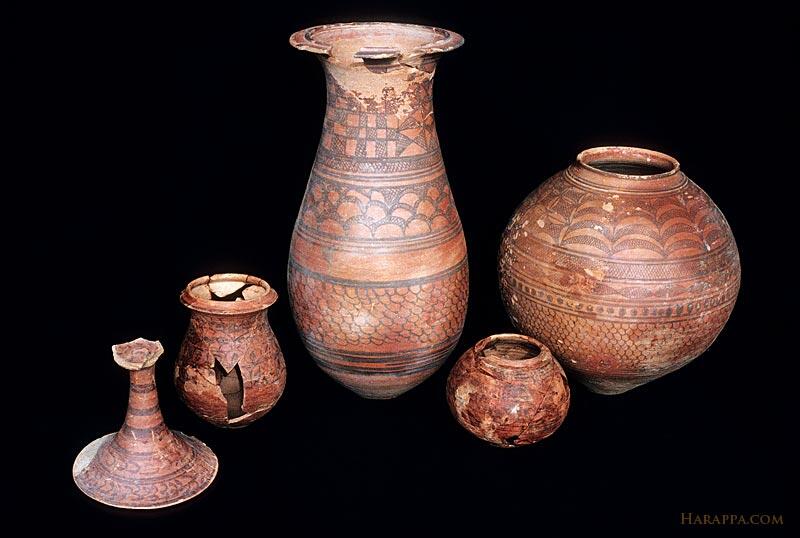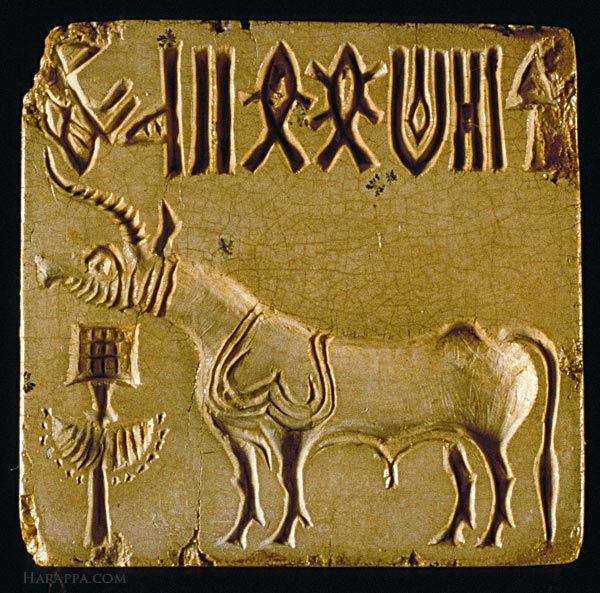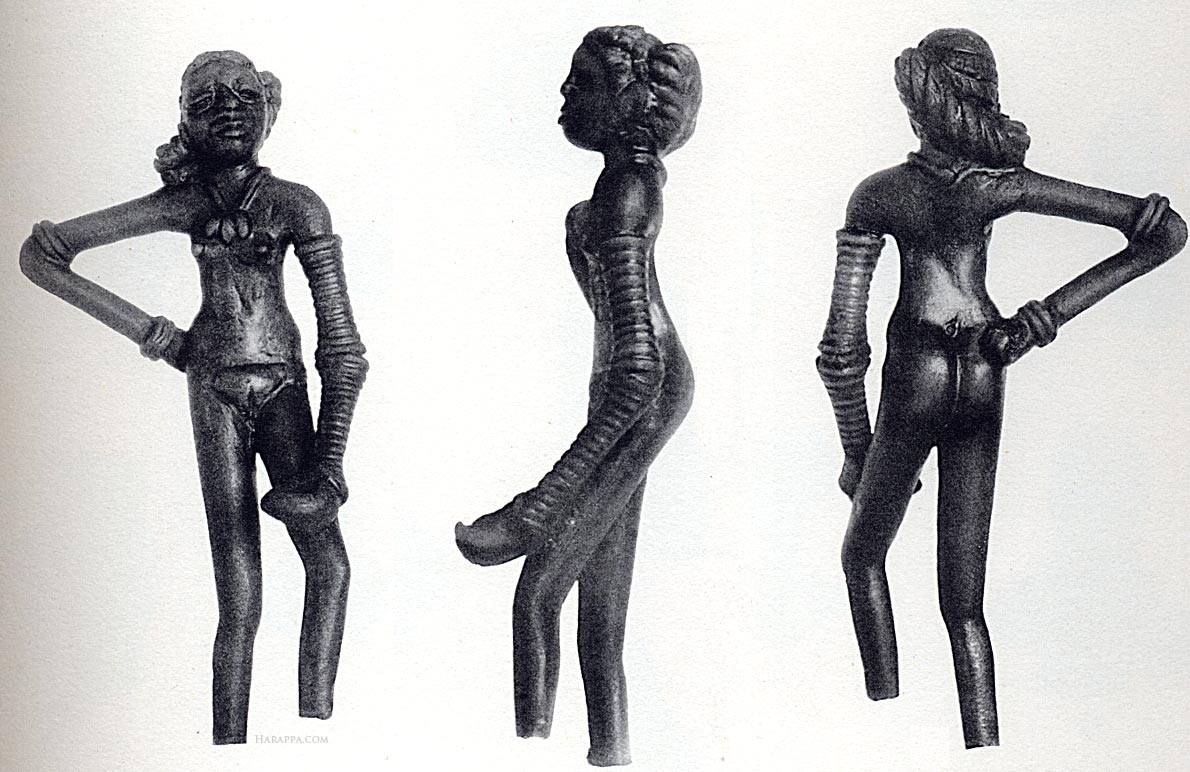Arts of the Indus Valley Civilization
Artifacts and artistic expressions from the Indus Valley Civilization, including sculptures, seals, and pottery, reflecting the advanced urban culture of the time.
- Arts of the Indus Valley Civilization emerged during the second half of the third millennium BCE The forms of art found from various sites of the civilisation include sculptures, seals, pottery, jewellery, terracotta figures, etc
- The two major sites of the Indus Valley Civilisation, along the Indus River—the cities of Harappa in the north and Mohenjodaro in the south—showcase one of the earliest examples of civic planning.
- Other markers were houses, markets, storage facilities, offices, public baths, etc., arranged in a grid-like pattern. There was also a highly developed drainage
- System. While Harappa and Mohenjodaro are situated in Pakistan, the important sites excavated in India are Lothal, and Dholavira in Gujarat, Rakhigarhi in Haryana, Ropar in Punjab, Kalibangan in Rajasthan, etc
1. Stone Statues
- Statues in stone, bronze or terracotta In stone are two male figures—one is a torsion red sandstone and the other is a bust of a bearded man in soapstone The figure of the bearded man, interpreted as a priest, is draped in a shawl coming under the right arm and covering the left shoulder. This shawl is decorated with trefoil patterns.
- The eyes are a little elongated, and half-closed as in meditative concentration
- the mouth is of average size with a close-cut moustache and a short beard and whiskers; the ears resemble double shells with a hole in the middle.
- The hair is parted in the middle, and a plain woven fillet is passed around the head. An armlet is worn on the right hand and holes around the neck suggest a necklace

2. Bronze Casting
- The art of bronze-casting was practised on a wide scale by the Harappans. Their bronze statues were made using the ‘lost wax’ technique.
- In bronze we find human as well as animal figures, the best example of the former being the statue of a girl popularly titled ‘Dancing Girl’. Amongst animal figures in bronze, the buffalo with its uplifted head, back and sweeping horns and the goat are of artistic merit. The copper dog and bird of Lothal and the bronze figure of a bull from Kalibangan are in no way inferior to the human figures of
- Copper and bronze from Harappa and Mohenjodaro.
- Metal casting appears to be a continuous tradition.
- The late Harappan and Chalcolithic sites like Daimabad in Maharashtra yielded excellent examples of metal-cast sculptures

3. Terracotta
- They are more realistic in Gujarat sites and Kalibangan. The most important among the Indus figures are those representing the mother goddess.
- In terracotta, we also find a few figurines of bearded males with coiled hair, their posture rigidly upright, legs slightly apart, and arms parallel to the sides of the body.
- The repetition of this figure in the same position would suggest that he was a deity.
- A terracotta mask of a horned deity has also been found. Toy carts with wheels, whistles, rattles, birds and animals, gamesmen and discs were also rendered in terracotta.

4. Seals
Archaeologists have discovered thousands of seals, mostly made of steatite, and occasionally of agate, chert, copper, faience and terracotta, with beautiful figures of animals, such as unicorn bull, rhinoceros, tiger, elephant, bison, goat, buffalo, etc.
The purpose of producing seals was mainly commercial.
It appears that the seals were also used as amulets, carried on the persons of their owners, perhaps as modern-day identity cards.
The standard Harappan seal was a square plaque 2×2 square inches, made from steatite. Every seal is engraved in a pictographic script which is yet to be deciphered.
Some seals have also been found in ivory. They all bear a great variety of motifs, most often of animals including those of the bull, with or without the hump, the elephant, tiger, goat and also monster.
Sometimes trees or human figures were also depicted.
The most remarkable seal is the one depicted with a figure in the centre and animals around it. This Seal is generally identified as the Pashupati Seal by some scholars whereas some identify it as the female deity. This seal depicts a
human figure seated cross-legged. An elephant and a tiger are depicted on the right side of the seated figure, while on the left a rhinoceros and a buffalo are seen.
In addition to these animals, two antelopes are shown below the seat.
Square or rectangular copper tablets, with an animal or a human figure on one side and an inscription on the other, or an inscription on both sides have also been found.
The figures and signs are carefully cut with a burin
5. Pottery
- Plain pottery is more common than painted ware.
- Plain pottery is generally of red clay, with or without a fine red or grey slip. It includes knobbed ware, ornamented with rows of knobs.
- The black-painted ware has a fine coating of red slip on which geometric and animal designs are executed in glossy black paint.
- Polychrome pottery is rare and mainly comprises small vases decorated with geometric patterns in red, black, and green, rarely white and yellow. Incised ware is also rare and the incised decoration was confined to the bases of the pans, always inside and to the dishes of offering stands.
- Perforated pottery includes a large hole at the bottom and small holes all over the wall, and was probably used for straining beverages. Pottery for household purposes is found in as many shapes and sizes as could be conceived.

6. Beads and Ornaments
Hoards of jewellery found at Mohenjodaro and Lothal include necklaces of gold and semi-precious stones, copper bracelets and beads, gold earrings and head ornaments, faience pendants and buttons, and beads of steatite and gemstones. All ornaments are well crafted. It may be noted that a cemetery has been found at Farmana in Haryana where dead bodies were buried with ornaments.
- The bead industry seems to have been well-developed as evidenced by the factories discovered at Chanhudaro and Lothal. Beads were made of carnelian, amethyst, jasper, crystal, quartz, steatite, turquoise, lapis lazuli, etc.
- Metals like copper, bronze gold, shell, faience terracotta or burnt clay were also used for manufacturing beads. The beads are in varying shapes—disc-shaped, cylindrical, spherical, barrel-shaped, and segmented
- Spinning of cotton and wool was very common.
- Spinning is indicated by finds of whorls made of expensive faience as well well of the cheap pottery and shells.
- Men and women wore two separate pieces of attire similar to the dhoti and shawl. The shawl covered the left shoulder passing below the right shoulder.
- From archaeological finds, it appears that the people of the Indus Valley were conscious of fashion. Different hairstyles were in vogue and wearing a beard was popular among all.
- Cinnabar was used as a cosmetic and facepaint, lipstick and collyrium (eyeliner) were also known to them. Many stone structural remains are also found at
- Dholavira shows how the Indus Valley people used Stone in construction.
- The artists and craftsmen of the Indus Valley were extremely skilled in a variety of crafts metal casting, stone carving, making and painting pottery and making terracotta images using simplified motifs of animals, plants and birds
7. Dancing Girl
The four-inch-high copper figure of a dancing girl. Found in Mohenjodaro, this exquisite casting depicts a girl whose long hair is tied in a bun. Bangles cover her left arm, a bracelet and an amulet or bangle adorn her right arm, and a cowry shell necklace is seen around her neck.
Her right hand is on her hip and her left hand is clasped in a traditional Indian dance gesture. She has large eyes and a flat nose
8. BULL
Bronze figure of a bull from Mohenjo-Daro. The animal is shown standing with his head turned to the right and with a cord around the neck.
The “Bull of the Indus Valley Civilization” refers to a famous artifact discovered at the archaeological site of Mohenjo-daro, one of the major cities of the ancient Indus Valley Civilization, which existed around 3300–1300 BCE in what is now modern-day Pakistan and northwest India.
This particular artifact is a well-known sculpture made of bronze, depicting a bull in a standing or sitting position. The bull is a revered animal in many ancient cultures, symbolizing strength, fertility, and sometimes a connection to the divine. The bull sculpture from the Indus Valley Civilization is no exception; it’s beautifully crafted and showcases the advanced metallurgical skills of that ancient civilization.
The bull statue is characterized by its lifelike and naturalistic representation, displaying intricate details such as muscular structure, horns, and a well-defined face. It’s believed that this bull might have been associated with religious or ritualistic purposes, possibly representing a deity or holding significance in religious ceremonies.
The significance and exact symbolism behind the bull in the context of the Indus Valley Civilization’s culture and belief systems remain subjects of scholarly debate and interpretation due to the lack of written records from that era. Nevertheless, artifacts like the Bull of the Indus Valley Civilization provide valuable insights into the artistic and cultural achievements of this ancient civilization

9. Male Torso
In this red sandstone figure, there are socket holes in the neck and shoulders for the attachment of the head and arms. The shoulders are well-baked and the abdomen is slightly prominent.
The Male Torso of the Indus Valley Civilization refers to another remarkable artifact found in the ancient sites of the Indus Valley Civilization. It’s a sculpted fragment that represents the upper part of a male torso, showcasing a high level of craftsmanship and artistic skill.
This particular artifact is notable for its lifelike portrayal of the human body. Though it’s only a fragment, the attention to detail in the depiction of muscles, shoulders, and a defined chest suggests a sophisticated understanding of human anatomy and artistic prowess during that era.
Similar to many artifacts from the Indus Valley Civilization, the exact interpretation and significance of this male torso remain a subject of scholarly debate. However, it’s believed that these sculptures might have had religious, ritualistic, or symbolic importance. Some experts speculate that these sculptures could represent deities, priests, rulers, or revered individuals within the society, possibly used in religious ceremonies or as symbols of power and authority.
The absence of written records from the Indus Valley Civilization makes it challenging to definitively interpret the cultural and religious significance of these artifacts. Nonetheless, they serve as valuable archaeological treasures that provide insights into the artistry, craftsmanship, and possibly the societal structures of this ancient civilization

10. Painted Earthen Jar
Found in Mohenjo-Daro, this jar is made on a potter’s wheel with clay. The shape was manipulated by the pressure of the crafty fingers of the potter. After baking the clay model, it was painted with black colour. High polishing was done as a finishing touch. The motifs are of vegetal and geometric forms.
The Painted Earthenware of the Indus Valley Civilization constitutes a significant part of the archaeological findings from this ancient civilization. Excavations at various sites within the Indus Valley, such as Harappa and Mohenjo-daro, have unearthed numerous pottery artifacts, including painted earthen jars or pots.
These painted earthenware items typically exhibit exceptional craftsmanship and artistic flair. They vary in size, shape, and decoration, showcasing the advanced skills of the civilization’s artisans. The pottery was often adorned with intricate designs and motifs, displaying geometric patterns, animals, plants, and occasionally human figures. The designs were painted using various pigments and dyes, displaying a range of colors including red, black, and white.
These painted earthen jars had several functions within the Indus Valley Civilization. They were likely used for storage purposes, holding grains, liquids, or other commodities essential for daily life. Additionally, some pottery items might have had ritualistic or ceremonial significance, being used in religious practices or as offerings.
The motifs and patterns found on these painted earthenware artifacts provide valuable insights into the artistic and cultural aspects of the Indus Valley Civilization. They indicate a sophisticated sense of aesthetics and artistic expression, reflecting the creativity and skill of the civilization’s artisans.
Studying these artifacts assists archaeologists and historians in understanding the daily life, cultural practices, and possibly the religious or symbolic beliefs of the people who lived during the time of the Indus Valley Civilization. However, the exact meanings and symbolism behind many of these designs and motifs remain open to interpretation due to the lack of deciphered written records from that era
11. Mother Goddess
The mother goddess figures are usually crude standing female figures adorned with necklaces hanging over prominent breasts and wearing a loin cloth and a girdle. The fan-shaped head-dress with a cup-like projection on each side is a distinct decorative feature of the mother goddess figures of the Indus Valley.
The Mother Goddess figures discovered in the context of the Indus Valley Civilization represent one of the intriguing aspects of this ancient culture’s artistic and religious practices. These artifacts often depict female figures with distinct characteristics that imply fertility, abundance, and sometimes a divine or motherly role.
The most famous depiction is the ‘Dancing Girl’ from Mohenjo-daro, although this particular artifact might not necessarily represent a goddess but rather a young woman. However, there are other figures and artifacts, such as terracotta statuettes, that suggest the presence of a mother goddess or fertility deity within the belief system of the Indus Valley Civilization.
These mother goddess figurines are usually portrayed with features emphasizing fertility and nurturing attributes. They might have exaggerated breasts, prominent hips, and sometimes be depicted with a headdress or other adornments. Scholars believe that these figurines might have had religious significance, possibly associated with fertility rites, rituals related to agriculture, or as symbols of nurturing and protective powers.
Interpreting the exact role or significance of these figures within the religious or social structure of the Indus Valley Civilization remains a subject of speculation and ongoing research. The absence of deciphered written records from that time period makes it challenging to definitively understand the religious beliefs and practices associated with these artifacts.
Nonetheless, these mother goddess figurines are significant archaeological discoveries that provide insights into the cultural, social, and possibly religious aspects of the ancient Indus Valley Civilization. They reflect the importance of fertility, nurturing, and possibly a reverence for feminine aspects within the beliefs and practices of that time
Download Our App Now!



